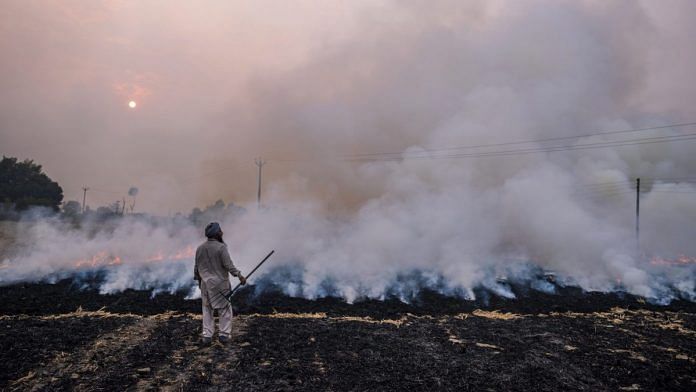New Delhi: Every year, as the winter season begins, the air quality index (AQI) of Delhi declines. The AQI in the national capital entered the ‘severe’ category Thursday. A major reason for the annual worsening of air is stubble burning by farmers in Punjab and Haryana.
We asked readers: What policies should the government introduce to tackle the struggle burning problem amid worsening air quality?
Here is what some of them said:
Harvesters should be modified, instead of asking farmers to stop
Before policy, I want to talk about why stubble burning is a problem. The primary problem is with the combine harvester, which leaves stems intact on the field while harvesting. Therefore, the cheapest and most convenient solution is to burn these stem to clear the field. The government has banned this burning and has also imposed fines on farmers. It also provides subsidy on machinery that allows for zero tillage farming. However, they still cost a lot and most farmers cannot afford them. The easiest and most affordable solution, then, is that the government should ask companies to modify the combine harvesters to tackle the root cause of the issue.
 Pooja Yadav, Hyderabad. Twitter: @PoojaY1301
Pooja Yadav, Hyderabad. Twitter: @PoojaY1301
Stubble burning needs to be dealt in scientific way
Stubble burning contributes to 18 per cent of the air pollution in Delhi. The most appropriate way to tackle stubble burning is to deal with it in a scientific way. IIT Ropar’s cost-effective machine can be a massive improvement on high-cost stubble management. Government should provide subsidy to farmers to buy these machines. Along with this, farmers should be encouraged to grow alternative crops like soybean, sorghum, maize and millets by providing them with incentives. A cost-effective PUSA decomposer, a fungi-based liquid solution is also another scientific way. The government can also bring a law to check stubble burning.
 Satyam Mishra, Dehradun. Twitter: @MSatyam81
Satyam Mishra, Dehradun. Twitter: @MSatyam81
Harvesters need to be educated about consequences
With the festive season colliding with the harvest period this year, the air pollution levels are bound to increase. Stubble burning is seen to be the quickest and most economical way of getting rid of the remnants of the harvest, however, it is also a major factor leading to the decline of air quality. Rather than imposing fines or creating rigid statutory policies, it is important to educate the harvesters about the consequences of their actions. When provided with due reason, they are likely to understand the gravity of the situation better and accept the proposals about alternative uses of stubble, as fodder or fuel, with greater enthusiasm.
 Avni Sharma, Chandigarh
Avni Sharma, Chandigarh
Need a multi-stakeholder and multi-disciplinary approach
Effective policies to holistically tackle air pollution will have to be multi-stakeholder and multi-disciplinary in approach. The first nail on the head would be to reduce the dependency on the typical paddy-wheat crop cycle through initiatives such as promotion of short duration paddy, boosting crop diversification through minimum support price for alternate crops and raising awareness among farmers about alternative crop options and associated economic and environmental benefits. However, these are medium-term to long-term measures. Immediate short-term measures should include modification of combined harvester to eliminate stubble and improving market linkage for the problematic non-basmati stubble.
 Anurodh Sachdeva, Berlin.Twitter: @anurodh08
Anurodh Sachdeva, Berlin.Twitter: @anurodh08
Govt should consider legislative modification, CSR funds to tackle stubble burning
In 2019, the Supreme Court said that the declining air quality in the NCR region was worse than the Emergency. Unabated stubble burning, industrial and construction activities are to blame for air pollution in Delhi and NCR. Stubble burning became an environmental problem after the water law passed by the Punjab government, which was then followed by Haryana. The moisture in air and slow north-westerly winds have aggravated the situation.
The following policies should be introduced to arrest the declining air quality. One, state governments should consider legislative modification to accommodate the concerns of air quality. Two, instead of being fined, farmers should be encouraged not to burn paddy stubbles. Three, corporate social responsibility funds and start-ups should
be mobilised to provide technological solutions. Four, inclusive and multi-stakeholder approach is a welcome step. The bottom-up and multi-pronged approach at implementation level is the way forward.
 Shruti Wankhede, Amrawati. Twitter: @Shruti84471040
Shruti Wankhede, Amrawati. Twitter: @Shruti84471040
Crop diversification and hand-holding can help with stubble burning
The government has come up with the AQI to measure pollution and stubble burning is one of the main causes of deteriorating AQI. The initiatives that can be taken, to this end, are:
– If the time between two crops is increased, farmers will not have to rush and burn the residue in the field for the next crop.
– Removing stubble through machines like ‘Happy Seeder’.
– Stubble can be used as an alternative fuel such as briquettes, which can also increase a farmer’s income.
– Using the PUSA decomposer by Indian Agricultural Research Institute (IARI) to decompose stubble without losing soil quality.
– Encouragement of crop diversification in Punjab and Haryana can help as it reduces area under rice and wheat.
– The government should not see farmers as law breakers. They must encourage them with technologies, financing and hand-holding.
 Navya Penmetsa, Visakahapatnam. Twitter: @prjunkie
Navya Penmetsa, Visakahapatnam. Twitter: @prjunkie
Alternative methods of harvesting need to be adopted
With only 10-15 days between the rice-harvesting season and the wheat-sowing time, farmers often burn the stubble to quickly eliminate the paddy stubble. This way is very easy for them but the huge clouds of smoke that rise up, blow into Delhi and contribute significantly to the national capital’s notorious winter-time air pollution.
There are multiple alternatives to stubble burning, and farmers can choose between the technologies and machines most suited to their particular local conditions, with the objective of ‘no burning’.
– Machines like ‘Happy Seeder’ — to cut down the rice stubble and sow wheat seeds simultaneously — can be used during harvesting. A straw baler can be used to compress crop residue into compact bales. And a paddy straw chopper-cum-spreader can be used to chop paddy straw left behind on mechanically-harvested paddy fields
– PUSA accelerates straw decomposition process into manure
– Stubble can be converted into biochar, which can be used as a fertiliser, by burning it in a kiln.
– In the longer term, long-duration paddy varieties can be replaced with shorter duration varieties, allowing enough time for the paddy stubble to decompose.
The government should play the part of an enabler by spreading awareness about the pros and cons of each option, to eliminate confusion and ease the adoption of new technologies by removing socio-economic barriers.
 Sandeep Wanchoo, Gurugram. Twitter: @swanchoo
Sandeep Wanchoo, Gurugram. Twitter: @swanchoo
Government needs to invest in research and development in agriculture
The agricultural sector is one of the most important sectors in the Indian economy. However, little attention has been paid for the welfare of farmers and agricultural activities.
While several initiatives have been undertaken by the government, most of them have turned to ash right at inception due to lack of proper financial or technical backing. Unlike other sectors, the agricultural sector is not well organised and most of the people engaged in this sector lack skill and knowledge about the innovative farming techniques. They also lack the means and financial aid for the same.
Therefore, instead of implementing existing techniques, the government should take initiative in research and innovation to uplift the sector and strengthen it from the core by empowering the farmers and by opening supporting industries to aid the growth of agriculture. While burning a gram of stubble may not release as many pollutants as a gram of plastic would, the huge quantity of the stubbles after each harvest magnifies the effect and thus contribute to pollution of the environment.
It is quite disappointing to know that most of what the government has done, so far, is to burn them for the farmers in alternative and fancy ways. They may be reducing the weight on the shoulders of the farmers slightly by doing the work for them. But are they doing it right? The government, with all its resources, should have already devised a better manner of disposal of the stubble that has a lesser ecological cost, rather than burning it for them.
Stubble is biodegradable. The possibility of manufacturing manure from it or making use of the same to increase the soil fertility would be a great idea to invest in. By doing so, we not only eradicate the pollution from the burning of the stubble, but also increase the soil fertility naturally, by giving back to nature. This will also help the farmers in cutting down the use of artificial fertilisers, reducing costs.
The state and central government could draw policies and allocate funds to local bodies to help the farmers build compost plants for stubble on application. To increase the plant capacity, the stubbles could be chopped using a machine before they are put into the compost plant. To ease the burden of maintaining a compost tank, the government may also direct the local bodies to undertake construction and maintenance of stubble, including collection from farmers for a nominal price and the compost can be sold in market.
Small scale and village industries that make crafts from stubble could be subsidised to attract new entrants. The government can set up bodies that will assist these small scale manufacturers in selling products in cities by educating them about marketing and selling techniques and by providing other necessary assistance.
It took me just about 10 minutes to come up with these ideas. I’m an ordinary citizen, which makes me wonder the possibilities that would open up if the governments took up the issue by seeing it as an opportunity rather than a problem and did something rather than following the same old pattern and routines.
 Elizabeth Divya Thomas. Twitter: @elivyathomas
Elizabeth Divya Thomas. Twitter: @elivyathomas
Policies need to focus on procuring waste, pyrolysis
Delhi’s meteorology and the quantity of chaff (crop residue or stubble) burnt in Punjab and Haryana play a major important role in worsening air quality. The problem arises due to the use of mechanised harvesting that leaves inches of stubble standing on the field and the subsidy-assured procurement of rice, which makes farmers act in haste for maximum production.
To prepare the field quickly for the sowing of winter (Rabi) wheat, farmers continue with this practice as it involves no cost. Equipment like Rotavator, which helps cut the stubble and mixes it with the soil, and ‘Happy Seeder’ are expensive. Also, the less number of biomass power plants operating in India has left no option for farmers. Stubble burning emits large amounts of toxic pollutants like methane (CH4), Carbon Monoxide (CO), Volatile organic compound (VOC) and carcinogenic polycyclic aromatic hydrocarbons. Stubble burning also leads to the loss of organic material for soil and effects the quality of groundwater.
What can be done:
– Policies should focus on procuring the waste and channelising it to make biochar and high-grade organic fertilisers can be prepared by mixing with cow dung and few natural enzymes.
– The government should encourage start-ups and NGOs to collect stubble and use it as an alternative to plastic.
– Co-operative societies of farmers, self-help groups, registered farmers societies or farmers groups, private entrepreneurs for establishment of farm machinery banks or custom hiring centres need to be developed.
– Encouraging pyrolysis, which is a sustainable way to generate electricity from waste. Using innovations like PUSA decomposers, which can give farmers the option to shred the straw, spray a solution containing fungal strains, and mix it with the soil for decomposition.
– Alternative cropping patterns should be encouraged like millets and quinoa which are in great demand due to health benefits.
– Community level interaction is the need of the hour with support of local- and district-level governance to educate farmers about the harm caused. Rewards and incentives need to be provided to farmers for selling stubble and buying ‘Happy Seeder’ machines.
The burden to act on menace of stubble pollution lies on the government and will to act for sustainability lies on farmers/producers.
 Anoop Meena, Rajasthan. Twitter: @adv_anoopm
Anoop Meena, Rajasthan. Twitter: @adv_anoopm
Policy needs to implemented at the grassroot level
There are more policies and plans in place than we could think of. The problem lies in targeting and approach, which is a part of policy framework. Farmers, the most crucial stakeholder of this debate complain of zero monetary assistance by government at grassroots. Some governments promised that they would buy the residue for alcohol production but procurement has not been done. Ultimate, policy should induce management of stubble and should be executed at the grassroots level.
Himanshu Ojha, Gorakhpur. Twitter: @himanshuojha11


